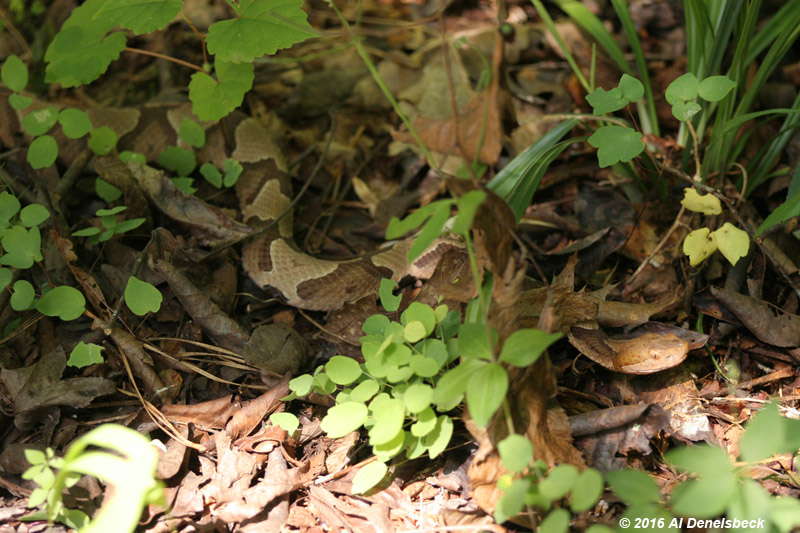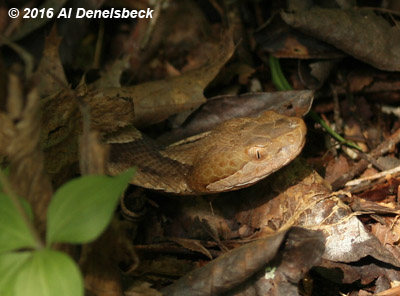Canon 30D, handheld
Mamiya 80mm at f8
1/100 second at ISO 250
Canon 30D, handheld |
| Learn the difference | |
 |
|
I have to say, a lot of people are really, really bad at identifying venomous snakes. And very often, these are the same people who feel that every venomous snake has to be killed on sight. Because, you know, such snakes will hunt you down tirelessly and bite you out of sheer spite and orneriness. I mean, just look at that face! Of course it's mean!
So yeah, you know where this is going. No snake is mean or aggressive, though occasionally one will be actively defensive, meaning it will respond sharply to a perceived threat (often enough, this is someone trying to kill it, you know, because.) Snakes don't change expression, and are no more mean than a raccoon; usually less so, to be honest. And if you leave snakes alone, you'll be fine. Seriously. Look up the stats on snake bites if you don't believe me. Even the cases where someone is bitten by accidentally stepping on one are rare – much rarer than getting injured in car accidents, though you don't see anyone avoiding driving.
But yes, it's still possible to encounter one by accident, especially in certain conditions, and this illustrates how easy it might be, at least for copperheads (Agkistrodon contortrix,) which have wonderful camouflage among leaves and forest litter. So if you need to know the difference (you probably don't,) here's a little illustration. Copperheads have a very 'airbrushed' or 'glowing' appearance to their patterns, with distinctive fading at the edges. The pattern is a dark hourglass-shape against a buff base, with the 'waist' or thinnest part of the hourglass crossing the spine – for all other non-venomous species in the region, the dark portion of the pattern is thickest across the spine. Copperheads have very distinctively triangular heads, almost equilateral, and the top of their heads are solid-colored without any pattern. If it doesn't match these traits, it's not a copperhead.
 There are two other distinctive traits of venomous snakes in the US, but neither is something that anyone is likely to be able to use during any encounter. One is the slit pupil like a cat, seen here; all non-venomous snakes have round pupils. And the other is the belly scales on the underside of the tail, just behind the vent. For non-venomous species, the scales become half-width and staggered instead of one scale crossing the underside from left to right like the forebody of the snake, while venomous snakes have the same full-width scales all the way down to the tip (or the rattle, in those cases.) Like I said, not exactly a useful guide, but it can help identify snake skins that have been shed.
There are two other distinctive traits of venomous snakes in the US, but neither is something that anyone is likely to be able to use during any encounter. One is the slit pupil like a cat, seen here; all non-venomous snakes have round pupils. And the other is the belly scales on the underside of the tail, just behind the vent. For non-venomous species, the scales become half-width and staggered instead of one scale crossing the underside from left to right like the forebody of the snake, while venomous snakes have the same full-width scales all the way down to the tip (or the rattle, in those cases.) Like I said, not exactly a useful guide, but it can help identify snake skins that have been shed.
These photos are a little ironic. I had just spent a few hours watching where I was walking carefully, knowing I was in prime conditions for encountering such a species, and had seen nothing. I was leaving the region and trekking up a heavily-trafficked gravel path well away from sheltering trees and any leaves, having let my guard down because I believed the risk was almost nonexistent, and came a bit too close to stepping on this one, which struck at me with lightning speed and vigor. No, that's a lie, it slipped hurriedly out of the way without the faintest hint of aggression or defensiveness, as timid as any field mouse, and I followed it until it paused so I could get the images. And as close as it seems here, I'm outside of striking distance, while the snake remained motionless and hoped that I would go away. Which I did, after less than a minute of shooting.
I would like to provide more guides for other venomous snakes, but here's the thing: I haven't encountered any. Ever. As often as I'm out there in ideal conditions, and ready to photograph them. In fact, this is only the second encounter of a copperhead in my life (provided you don't count the management calls that I went on when working for animal rescue – I had never made initial contact myself, so I personally don't count those.) I see plenty of other species, all harmless – generally at least a half-dozen a year. It surprises even me, to be honest...
